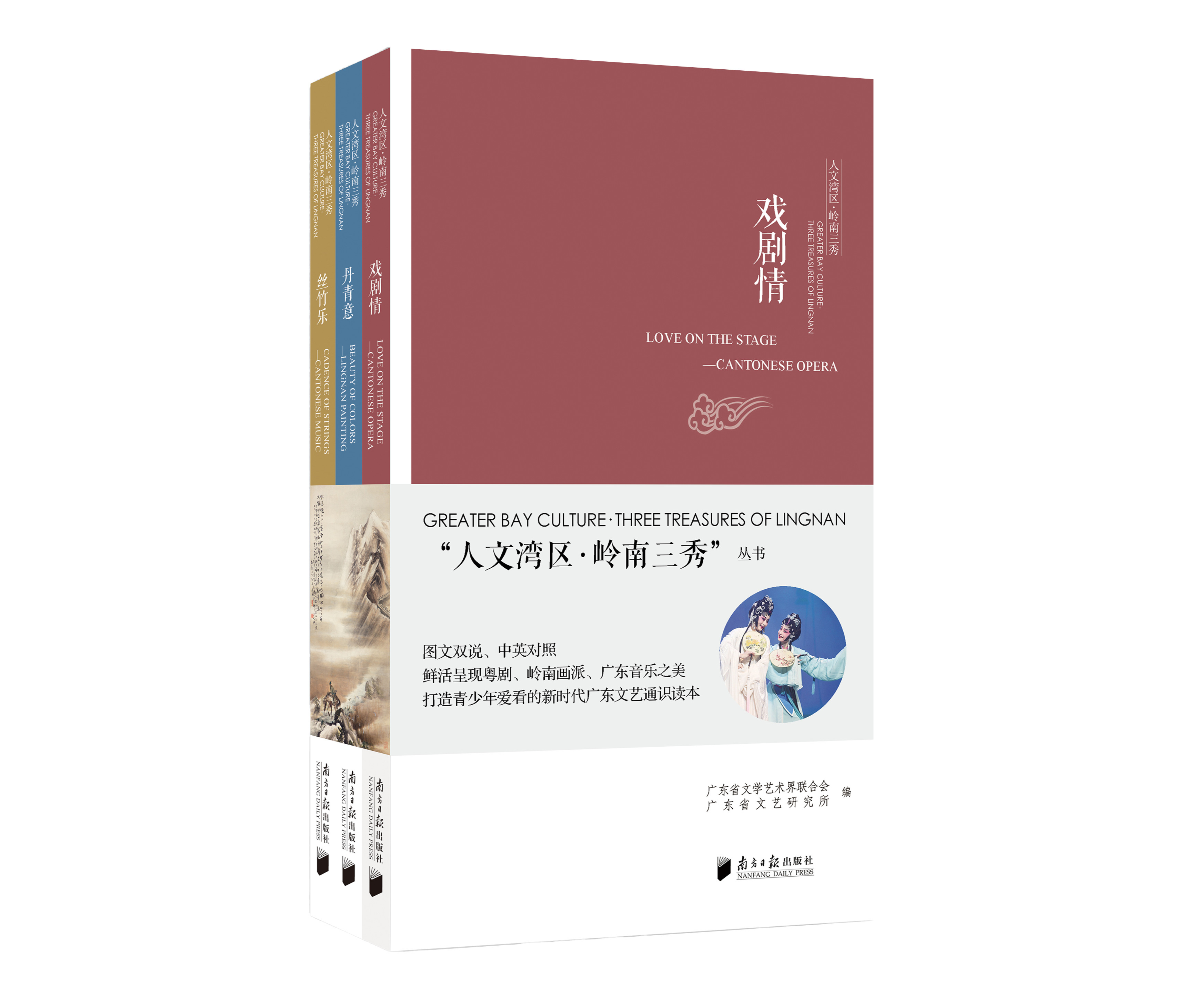南方网讯 粤剧、岭南画派和广东音乐是岭南文化中最具代表性艺术形式,被誉为“岭南三秀”。这三种艺术可观、可听、可珍藏,别具艺韵文心,具有深厚的文化底蕴,至今仍涌动着创新活力,为粤港澳大湾区民众以及海外华侨华人喜闻乐见。

由南方日报出版社出版,广东省文学艺术界联合会和广东省文艺研究所联合编著的“人文湾区·岭南三秀”丛书英文版以岭南三秀打造人文湾区文化名片,向读者从多角度解读粤剧、岭南画派、广东音乐这三大艺术,以中英双语对照的形式,打造向青年普及岭南传统文化的文艺通识读本。“岭南三秀”本身即代表了地域文化精神,亦有独特艺术魅力,不仅体现了大湾区文化软实力和人文精神内涵,更颇具“走出去”的开放气质,为外国友人领略岭南文化提供了发现之窗。
《丹青意》介绍普及了岭南传统文化——岭南画派。岭南画派发源于粤,以“二高一陈”即高剑父、高奇峰和陈树人为主要创始人,拉开了近百年岭南画坛大变革的序幕。在此后的半个多世纪里,以岭南画派为代表的广东美术,开创了中国画坛新格局,引领近代中国美术走上现代转型之路,筑就了高剑父、高奇峰、陈树人、关山月、黎雄才、赵少昂等多座艺术高峰,与海上画派、京津画派三足鼎立,成为中国近现代画坛活力、有影响的艺术流派之一,在百年岭南美术史乃至中国美术目前,写下了绚丽璀璨的一页。岭南画派独具时代精神和地方特色的艺术风格,开启了一个属于新国画的时代。
《丝竹乐》介绍普及了岭南传统文化——广东音乐。广东音乐是我国民间音乐的重要乐种,也是非物质文化遗产之一,拥有一批杰出的作曲家、演奏家和代表性乐器。广东音乐与粤剧、岭南画派并列为“岭南三大艺术瑰宝”,初流行于广东省珠三角、台山及港澳等地区,后渐流传至全国各地及海外华人之中,影响甚广。
《戏剧情》介绍普及了岭南传统文化——粤剧。粤剧被誉为“南国红豆”,在全国戏剧艺术中占有突出地位,影响遍及全世界。作为“岭南文化三瑰宝”之一的粤剧,不仅是广东一张生动鲜活的文化名片,也是联结粤港澳大湾区三地民众文化情感的纽带。本书通过对粤剧的发展历程、名伶及代表作、粤剧与广府文化的关系,以及粤剧在港澳台和海外的传播等几个方面,让读者对粤剧有多方面的认识,使这种很好的传统文化得以传承并发扬光大。

扫描二维码,查看图书购买详情
作者简介
广东省文学艺术界联合会(Guangdong Federation of Literary and Art Circles ):成立于1950年9月,是中共广东省委领导的,由全省性的文艺家协会、地级市以上文学艺术界联合会和全省性的产业文联组成的文学艺术界专业人民团体,是党和政府联系文艺家的桥梁和纽带,是繁荣社会主义文艺、发展先进文化重要力量。
广东省文艺研究所(Guangdong Institute of Literature and Art):建于1963年,是广东省文联下属的事业单位。主要部门有:音乐研究室、综合文化研究室、录音棚、民族民间音乐电子资料库、乐谱排版部等。
精彩书摘
粤剧,广州本地人亲切地叫它作“大戏”,又有“广府戏、本地戏”的叫法,是我国华南地区影响最大、流行最广的地方剧种。它产生于广府文化中心(佛山、广州),秉承岭南文化兼容、务实、开放、创新的特征,吸取了昆剧、弋阳腔、秦腔、汉剧等外来剧种的精华,博采众长,自成一格。
Cantonese Opera, affectionately called by the people of Guangzhou as “Grand Opera”, “Guangfu Opera”, or “Local Opera”, is the most influential and the most popular opera in South China. (Note: Every province in China has a simplified name. The simplified name for Guangdong Province is “粤”, a Chinese character read as “yue”. “Cantonese Opera” is traditionally called “Yue Opera”. In the same way, “Beijing Opera” is often called “Jing Opera”, while those popular in Guangxi, Hubei and Hunan provinces are called respectively as “Gui Opera”, “Han Opera”, and “Xiang Opera”. Sometimes Cantonese Opera is also called “Guangfu Opera”. “Guangfu” refersto a larger area, including Guangzhou,Hong Kong, Macao, and other places in Zhujiang River Delta. ) Rooted in Foshan and Guangzhou, the center of Guangfu Culture, it inherits the core elements of Lingnan Culture (Note: Lingnan refers to the region to the south of the fives mountain ridges in South China. The five ridges are Yuecheng Ridge, Dupang Ridge, Mengzhu Ridge, Qitian Ridge and Dayu Ridge. And Lingnan Culture refers to the culture shared by this region.) to be inclusive, practical, open and creative and absorbs the essence of Kun Opera, Yiyang Opera, Qin Opera, Han Opera and other foreign operas to form its unique style.
粤剧广泛流行于粤语地区,包括两广地区(广东、广西)、香港、澳门等地。在海外,粤剧被称作“Cantonese Opera”,译为“广东歌剧”。在东南亚、美国、加拿大等华侨聚集地都能寻见其活跃的身影。“故有广东人足迹,即有广东人戏班,海外万埠,相隔万里,亦如在广东之祖家焉。”粤剧成了海外传播时间最长、传播范围最广的剧种。
Cantonese Opera is popular in the Cantonese-speaking regions, including Guangdong, Guangxi, Hong Kong, Macao and the neighboring places. Traditionally called “Yue Opera” by Chinese people, it is widely known as “Cantonese Opera” abroad. It is quite popular in the overseas Chinese communities in Southeast Asia, the United States and Canada. Someone with the penname “Wuyasheng” published his reflections on Cantonese Opera on a Chinese newspaper called Wenxing News edited by the overseas Chinese in California of the United States, and said that wherever the Cantonese lived, there was a Cantonese Opera troupe, and though thousands of miles away from their hometown, the Cantonese felt like being at home whenever watching the performance. Cantonese Opera is believed to be the most popular Chinese Opera in foreign countries where it has a long history of transmission.










